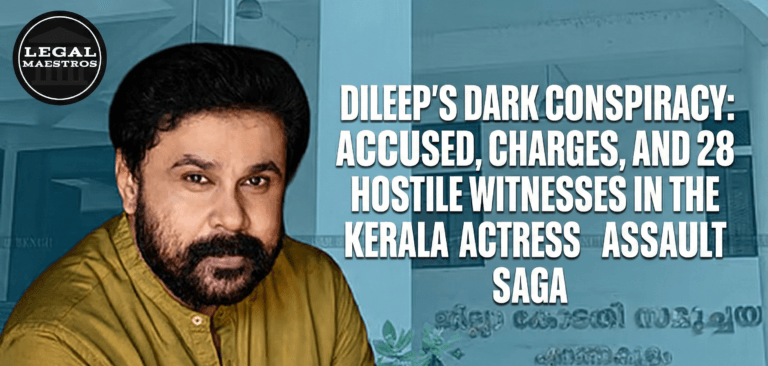
The public’s attention was drawn to the situation involving the actress Ranya Rao at the beginning of March 2025. In addition to being well-known for her appearances in Kannada films, she was accused of engaging in substantial gold smuggling. She was accused of bringing precious metal into India without disclosing it, which was worth crores of rupees, according to the authorities.
The effectiveness of India’s anti-smuggling framework is demonstrated by the fact that she was arrested and is still being held under a special preventive statute. The chronology of events, the legal obstacles, and the role that the COFEPOSA Act played in keeping her behind bars despite the fact that a judge granted bail are all topics that are discussed in this article.
For More Updates & Regular Notes Join Our Whats App Group (https://chat.whatsapp.com/DkucckgAEJbCtXwXr2yIt0) and Telegram Group ( https://t.me/legalmaestroeducators )
For any queries or to publish an article or post or advertisement on our platform, do call at +91 6377460764 or email us at contact@legalmaestros.com.
Details of the Arrest and the Seizure
Ranya Rao arrived in Bengaluru from Dubai on March 3, 2025, and entered the city through the Kempegowda International Airport. For the purpose of conducting a routine check, intelligence officials from the DRI stopped her. They found gold bars hidden around her waist, calves, and within her shoes when they were conducting the search and seizure procedure.
A total of about 14.2 kilograms of gold, with a value of more than twelve crore rupees, was taken into custody by the officers. It has been stated that further searches conducted at her apartment uncovered additional items of jewelry as well as significant amounts of cash. As a result of the DRI’s allegations that these items were a part of a coordinated smuggling operation, a formal case was filed in accordance with the Customs Act and other statutes that are relevant to it.
The Results of the Investigation and the Network
Investigators were able to establish a connection between Ranya Rao and a larger smuggling network after she was arrested. During the period beginning in January 2025, surveillance and records indicated that she had made many journeys to Dubai, which raised suspicions regarding her frequent travel patterns. According to the findings of the investigation conducted by the DRI, hawala routes were used to transfer money from India to international markets for the purpose of purchasing gold.
Two further crucial figures have been discovered by the authorities. These individuals are Sahil Sakaria Jain, a hawala operator, and Tarun Konduru Raju, a Telugu actor and businessman. The evidence pointed to Jain’s participation in enabling the illegal financial transfers and disposing of smuggled gold, which further solidified the impression that an organized syndicate was involved.
In accordance with the Customs Act, default bail
Regarding offenses such as smuggling, a chargesheet is required to be submitted within sixty days of the arrest, as stipulated by the Customs Act. Since March 3, Ranya Rao had been detained, and by May 2, the deadline had passed without the Department of Revenue and Investigation (DRI) having issued a formal chargesheet.
On May 20, 2025, a court that specializes in economic offenses granted her bail in default of her appearance. As a result of the procedural error, the court issued an order for her release on the condition that she post a personal bond of two lakh rupees with two sureties. On the other hand, despite the fact that she was eligible for bail by default for nineteen days, she was still unable to be released because of overlapping detention orders under other statutes.
In accordance with COFEPOSA, Preventive Detention
According to the COFEPOSA Act, which was passed into law in 1974, the authorities have the authority to issue preventative detention orders against individuals who are judged to be likely to commit smuggling or foreign exchange offenses. An order of this kind was issued against Ranya Rao and her co-defendant on April 22, 2025, by the Central Economic Intelligence Bureau, per the recommendation of the Directorate of Revenue Investigation.
According to this law, detention is permitted without the ordinary bail rights that are given under the regulations of criminal procedure. In an effort to discourage repeat offenses, the order may be in effect for a period of up to one year. As a consequence of this, Ranya Rao continued to be held in custody in accordance with this severe preventative framework even after the court granted default bail.
Conflicts in the Courts and Appeals
The legal team representing Ranya Rao has engaged in a number of judicial battles in order to obtain her freedom. Initial bail applications that were brought before the special economic offences court and the Bengaluru sessions court were denied. The judges cited the seriousness of the offense as well as the possibility of evidence being tampered with as the reasons for their decision.
Her legal representatives filed a challenge against the COFEPOSA custody request in the Karnataka High Court after the default bail order was issued. A habeas corpus petition was also submitted by the actor’s mother, in which she argued that the preventative detention order was unreasonable and did not have adequate grounds. Due to the fact that the High Court had not yet rendered a decision on these petitions as of the end of May 2025, her legal future remained uncertain.
The Effect on the Co-Accused
The legal outcomes for Tarun Konduru Raju and Sahil Sakaria Jain are comparable to one another. Following the arrest of Ranya Rao at the beginning of March, Raju was also taken into custody and denied bail in accordance with the rules of both the Customs Act and COFEPOSA. As well as being jailed, Jain, who has been identified as a significant hawala link, is contesting the COFEPOSA order that was issued to him.
The continuing incarceration of the three individuals demonstrates the extensive power that preventative detention statutes have in cases involving smuggling. The legal teams representing these individuals have contended that these regulations circumvent the ordinary judicial examination and violate fundamental rights; however, the courts have maintained the detention orders as being required for the purpose of ensuring economic security.
An Examination of the Provisions of COFEPOSA
The preventive detention powers granted by the COFEPOSA Act continue to be a contentious issue. There are many who believe that the law, because it circumvents the standard procedures for bail and remand, can be abused and violates the individual’s right to personal liberty.
Proponents argue that smuggling rings are able to quickly adapt to new circumstances and that preventive detention is necessary in order to stop organized networks before they can reconstruct themselves.
Regarding Ranya Rao, the authorities provided a justification for the order by referring to her suspected recurrent travel for the purpose of smuggling and her refusal to cooperate during the investigations. In spite of the fact that the preventative method seeks to safeguard the economy, it raises concerns regarding the right to a fair trial as well as the existence of checks and balances.
When it comes to India’s war against smuggling, the Ranya Rao gold smuggling case brings to light the intersection between preventative detention and procedural safeguards.
The severe provisions of the COFEPOSA Act have made it impossible for her to be released from jail, despite the fact that a judge granted default bail on procedural grounds.
Despite the fact that this dual-layered legal reaction highlights contradictions between individual liberty and preventative measures, it also represents the state’s focus on deterrence and economic security.
As the appeals of Ranya Rao continue to be heard, it is possible that her case could establish significant precedents for the manner in which Indian courts strike a balance between the rights of accused people and the perceived harm posed by organized smuggling activities.




